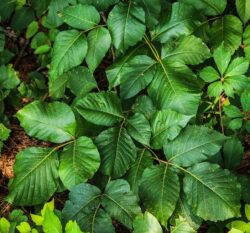If you’ve ever had a rash from poison ivy, you probably take precautions to assure the plant isn’t growing in and around your yard and avoid it as best possible. Each year, we receive calls from homeowners about poison ivy and the best way to remove the troublesome plant. We’ve put together this list, answering some of the most common questions about poison ivy and measures you can take.
1. Is the rash contagious to others?
 The rash is not contagious to others once the oil has absorbed into the skin. However, the oil can be transferred to others on contact, from pets or even gloves and tools. You will need to wash your clothing and gear thoroughly before you use them again.
The rash is not contagious to others once the oil has absorbed into the skin. However, the oil can be transferred to others on contact, from pets or even gloves and tools. You will need to wash your clothing and gear thoroughly before you use them again.
2. Can I give or get poison ivy from my pets?
The density of most pet fur will keep the oil from coming in contact with you pet’s skin. Although, thinner areas around the belly may be more susceptible for your pets to get a rash. It is also possible, if they have been through an area with poison ivy, that you can come in contact with the oil on there fur by simply petting them. If you suspect your pet has come in contact with a poisonous plant, you will want to you bathe your pet and use rubber gloves for the process!
3. Can you get poison ivy any time of year?
The urushiol is found in all parts of the plant. Therefore, even if the leaves have fallen off, the oil is still in the vines. Handling and cutting the vines in the winter can expose you to the oil inside.
4. If I have poison ivy, can I still go in my pool or will others get it?
After the oil has been washed off, it will not transfer. Ideally wash before going in the pool. However, if you are unaware of your contact with poison ivy and go swimming the volume of the water and chlorine will also reduce the ability for the urushiol to contaminate others.
5. If I want to get rid of poison ivy plants around my yard, is it safe to burn them?

Burning will vaporize the oil in the plant and make it possible to inhale the oil causing an internal rash and externally as well from the smoke. We do not recommend this method of removal as it can be quite harmful and possibly require hospital care.
6. What are the best methods for control?
Poison ivy can be pulled by hand if you are mindful not to make contact with your skin and discard gloves and other clothing that comes in contact with the plant. The oil can remain active for several years even after killed. Vines growing up into trees can be cut near the ground and the aerial portions of the plant will die. The rest of the vine growing up the tree may not be able to be removed safely depending on size.
Herbicides like glyphosate and triclopyr can be used to treat poison ivy and will translocate down to kill the roots. Organic sprays like vinegar will damage the leaves and cause defoliation, but will not move in the plant to kill roots. Therefore, they will continue to sprout new leaves unless all carbohydrate reserves are s
pent.
7. Are there any good home remedies to help a poison ivy rash?
Wash with cold water as soon after contact as possible to avoid opening pores and removing the oil before it can absorb into the skin. Soap may also spread the oil. Rubbing alcohol can help remove the oil from tools. There are over -the-counter washes that may help, but you need to have those on hand soon after you make contact. Other treatments are available after the rash has developed to help reduce itching and dry up the rash which can last for several weeks.
8. How can I tell the difference between poison ivy/oak/sumac?

Leaves of three let them be! Poison ivy has 3 leaves with smooth edges. The vine has lots of tendrils that make it look like a hairy rope (hairy rope, don’t be a dope!).
Poison sumac is only found in really wet swampy areas and is not encountered commonly. Poison sumac has long compound leaves with lancelet leaflets. Common staghorn sumac does not contain the urushiol that causes the skin irritation and rash. Poison oak only grows in the southeast and west coast, but has lobed leaves like an oak tree but arranged in 3’s like poison ivy.
9. Can I be immune to poison ivy?
People can vary in there sensitivity to urushiol and different parts of the body are more sensitive than others. Because you have not gotten a rash in the past does not mean you will not in the future.
We hope you have found this information helpful. If you are ever in question or need for poison ivy removal, please reach out to us at (781) 297-3674 – we are here and happy to help!
